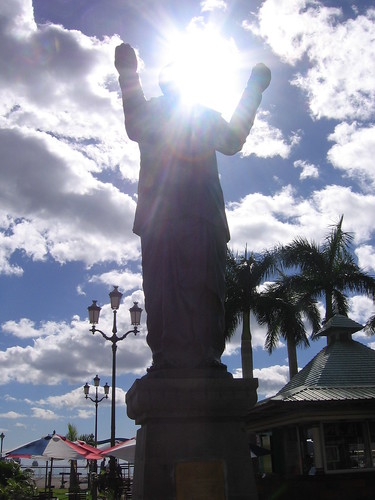A whirlwind tour, part two
On the flight from Amman to Cairo, I was sitting next to a group of pilgrims who had been to Mecca for the Haj. The group comprised a man in his sixties, a younger man (possibly his son) and five women of varying ages wearing Burqas. The father, sitting right next to me, spoke good English and we engaged me in conversation about my trip to the Middle East and the wisdom of the Koran. Upon landing, I was amused to spot a pair of Puma tracksuit bottoms peeking out from beneath the Burqa of one of the group.
Cairo is a city that specializes in a certain kind of adventure travel. I don't mean a trip to the pyramids or a cruise down the Nile (though these are unforgettable experiences). The adventure is getting into a car and hoping that you'll get out safely at your destination. It is not only the seemingly insane driving that causes your stomach to leap into your throat (road markings are just for show, and drivers change lanes constantly and for no apparent reason), it is also the fear of ploughing into the pedestrians who fearlessly stroll out in front of the traffic, or sprint across three lane highways! Fortunately, my driver, Hassan, was well versed in Cairene road etiquette and I only thought we were going to crash, say, half a dozen times.
The traffic chaos is actually quite endearing and, despite the choking pollution and its sheer size, I really like Cairo. It is such a vibrant city. And rapidly expanding. Driving from one side of Greater Cairo to the other takes about an hour. I also spent some time out at 6th of October City (named after the Yom Kippur war of 1973), an industrial new town of about 50,000 people a little way outside the city's sprawl. Here many of Egypt's industrial showpieces have been built or are under construction. Cheap natural gas and low labour costs, together with recent reductions of individual and corporate taxation levels are encouraging increasing foreign direct investment in the country. And, as hard evidence, there were plenty of new factories and apartments under construction.
After watching the sound and light show at the pyramids of Giza (fantastic lights, hokey commentary), I was invited to dinner on board a floating restaurant called Le Pacha. Built in 1903, this boat has 11 different resturants (French, Italian, Lebanese, etc), and the Chinese-Japanese fare we sampled in L'Asiatique was very good. And popular too with a foreign Egyptian foreign minister who (so I was told) was seated at the next table.
On the way back to the airport the next morning, Hassan took me through Heliopolis, the grandest part of Cairo, and home to politicians and wealthy industrialists. One of the key movers in the district's development was a Belgian, Baron Empain, whose former home was modelled on the Cambodian Temple complex of Angkor Wat. Now abandoned to a colony of bats, it was an incongruous yet somehow fitting final glimpse of a great city.
Cairo is a city that specializes in a certain kind of adventure travel. I don't mean a trip to the pyramids or a cruise down the Nile (though these are unforgettable experiences). The adventure is getting into a car and hoping that you'll get out safely at your destination. It is not only the seemingly insane driving that causes your stomach to leap into your throat (road markings are just for show, and drivers change lanes constantly and for no apparent reason), it is also the fear of ploughing into the pedestrians who fearlessly stroll out in front of the traffic, or sprint across three lane highways! Fortunately, my driver, Hassan, was well versed in Cairene road etiquette and I only thought we were going to crash, say, half a dozen times.
The traffic chaos is actually quite endearing and, despite the choking pollution and its sheer size, I really like Cairo. It is such a vibrant city. And rapidly expanding. Driving from one side of Greater Cairo to the other takes about an hour. I also spent some time out at 6th of October City (named after the Yom Kippur war of 1973), an industrial new town of about 50,000 people a little way outside the city's sprawl. Here many of Egypt's industrial showpieces have been built or are under construction. Cheap natural gas and low labour costs, together with recent reductions of individual and corporate taxation levels are encouraging increasing foreign direct investment in the country. And, as hard evidence, there were plenty of new factories and apartments under construction.
After watching the sound and light show at the pyramids of Giza (fantastic lights, hokey commentary), I was invited to dinner on board a floating restaurant called Le Pacha. Built in 1903, this boat has 11 different resturants (French, Italian, Lebanese, etc), and the Chinese-Japanese fare we sampled in L'Asiatique was very good. And popular too with a foreign Egyptian foreign minister who (so I was told) was seated at the next table.
On the way back to the airport the next morning, Hassan took me through Heliopolis, the grandest part of Cairo, and home to politicians and wealthy industrialists. One of the key movers in the district's development was a Belgian, Baron Empain, whose former home was modelled on the Cambodian Temple complex of Angkor Wat. Now abandoned to a colony of bats, it was an incongruous yet somehow fitting final glimpse of a great city.
Labels: On the road

0 Comments:
Post a Comment
<< Home